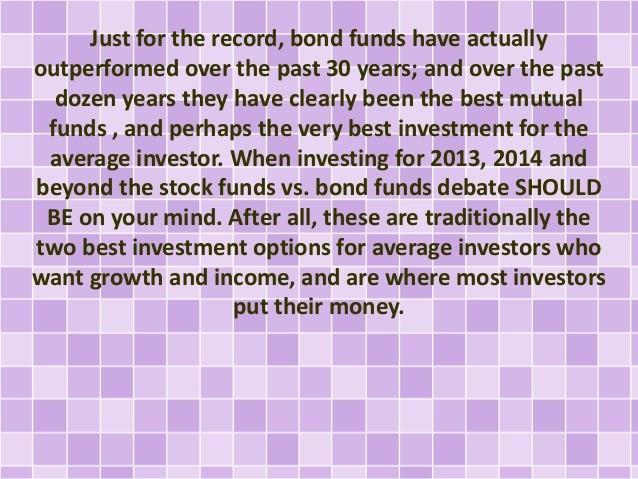What Are the Best Ways to Invest in Mutual Funds
Post on: 1 Июль, 2015 No Comment

Most of us have a pretty good idea what mutual funds are about. so maybe the more relevant question is, what are the best ways to invest in mutual funds?
There are different ways to own them, different times and methods to invest, and even other assets we might like to hold in addition to mutual funds.
Properly used, mutual funds can increase investment returns substantially.
But view them as passive, invest-and-forget vehicles, and they may be no better than owning individual stocks.
Mutual fund family vs. brokerage accounts
Keeping all of your mutual funds in a single fund family has the advantage of saving you money on transaction fees. You can generally buy and sell fund shares without having to pay a commission (over and above any load fees, if they apply).
Fund families also typically allow you to switch from one fund to another without charging an exchange fee. There’s usually a limit on the number of times you can do this in any given year so a fund family may not save you much if you’re looking to actively trade funds.
Brokerage firms offer mutual funds and while they charge small commissions for buying and selling of funds, they offer a wider variety of funds than fund families do.
This is true because brokerage firms offer the funds of many mutual fund families, which means the investment choices are far greater than if you have all of your holdings with a single fund family.
Another advantage they have over fund families is that you can hold other investments, like stocks, bonds and ETFs, in the same account, eliminating the need to maintain multiple investment accounts.
If you work with a discount broker and invest only in no-load mutual funds, the cost in transaction fees versus fund families may be insignificant.
Dollar cost average, or take the plunge?
This question applies with mutual funds just as it does with individual stocks.
Dollar cost averaging —accumulating your investment positions gradually through regular periodic contributions—lowers your risk because you’re investing your money slowly and over a long period of time, rather than all at once.
Advertisement
Which way you go with this may depend on recent market activity.
If the market has been dropping, you may want to take a large position as soon as the market seems to have settled down. If the market has been rising steadily, dollar cost averaging could lower the risk in the event of a reversal.
Mutual fund families are particularly well suited to dollar cost averaging because mutual funds typically allow for ongoing contributions without charging transaction fees.
Most funds will require that you first open a minimum balance in a given fund, typically $1000, which you can then add to through payroll contributions or some other form of periodic investment without having to pay transaction fees.
In this way, you’ll be both taking a plunge and then dollar cost averaging.
Even with mutual funds you still need to diversify
What are the best ways to invest in mutual funds?
There’s a temptation to think that a mutual fund handles diversification for you, but tread lightly here.
Mutual funds do diversify in the sense that they spread your investment over many different securities—so far, so good.
But most of those securities will be in the same investment class .
For example, a growth fund is invested almost entirely in stocks, and generally high risks stocks at that.
The primary purpose of diversification though is to invest in entirely different investment classes, like stocks, bonds and cash. There are mutual funds that do this, called balanced funds. which may or may not work for you.
Balanced funds maintain a certain asset allocation mix that’s fixed, which is to say that it may not have the blend that works for you, or for the market environment of the time.
It may be better to handle diversification outside of a mutual fund, one that better suits your risk tolerance, and use mutual funds as components.
You can, for example, use growth mutual funds for the stock component of your portfolio, add in US Treasury notes and bonds for your bond allocation, and hold money markets, certificates of deposit or US Treasury bills as the cash portion.
Your bond and cash allocations will be unaffected if your growth stock mutual funds fall, and that’s what diversification is all about.
Experimenting beyond mutual funds
Most of us are not stock experts—we have day jobs that occupy the bulk of our time most days. We want to be in the market, but we prefer doing so with professional management.
Mutual funds are made for the majority of investors!
For this reason, if you’re a typical investor, mutual funds should form the foundation of your risk investments—the place where the greatest portion of your equity investments sit at any given time.
From this platform, you can feel free to experiment. If you keep, say, 80% of your risk investments in stock mutual funds. you can use the remaining 20% to try your own hand at investing in individual stocks. In this way you will be gaining valuable investment experience and may even find a serious winner or two without risking the bulk of your money on positions that could just as easily go the other way.
View mutual funds as an investment tool properly used they can be a tremendous asset in your effort to build a substantial investment portfolio. At the same time, recognize that it’s still entirely up to you to make the crucial decisions as to when, where and how much you invest.
What do you think are the best ways to invest in mutual funds?
Free Newsletter to Keep you Free From Broke!Name: Email: We respect your email privacyPowered by AWeber email marketing














